Forests and parks in Warsaw
#Warsaw tour guide #Warsaw city guide # guided tour in warsaw #Warszawa tour guide #Warszawa city guide #guided tour in Warszawa
You won’t be in Warsaw for long before you realise that the city is filled with trees and blades of grass. Around 15% of the Warsaw municipality is made up of actual forest area, and forests are generally allowed to grow much more freely than in many other countries. As a selection of the many beautiful and wild forests, I have selected three:
Bielany Forest – almost wild. Go by bike from the centre
The northern part of the Wisła River. Approx. 1 km from Metro Stare Bialany. Approx. 6-7 km bike ride along the river (cycle path) from Old Town.

One of the city’s highest areas offers dense forest, diverse wildlife and great views of the river
A high-altitude park with a line park (park linowy Bielany) for the kids, a long lake with cosy bars and restaurants and great views of the riverbank and the city.
Kabata Forest and the Park of Culture in Powsin
(Park Kultury w Powsinie). A little over a kilometre from the Kabaty metro or bus 519 from the Central Railway Station or Constitution Square (Dw. Centralny or Plac Konstytucji) all the way up to the Park Kultury w Powsinie (the terminus).
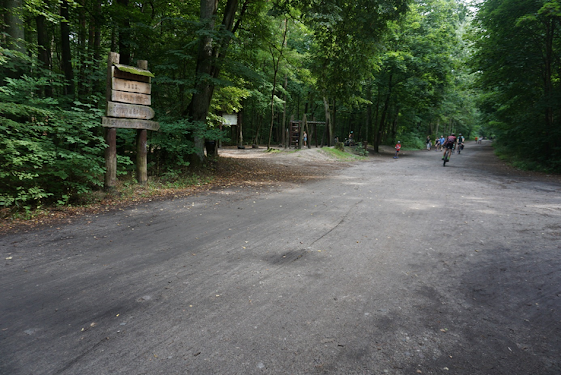
There are good trails between the woodlands and the area is popular for long bike rides or running
A huge (1000 hectares) nature reserve on a relatively flat terrain. It contains a number of centuries-old trees with a wide variety of species that are sure to be appreciated by those with a knowledge of nature’s diversity. The entire reserve is covered by trails, which should be followed if you are not familiar with the area.
Part of the Kabata Forest includes the 35-hectare Cultural Park in Powsin. Especially in summer, this is a great place for all ages with sports fields, a swimming pool, a pavilion for concerts, chess tables and, of course, places to buy lemonade, beer and food, but many people bring packed lunches.
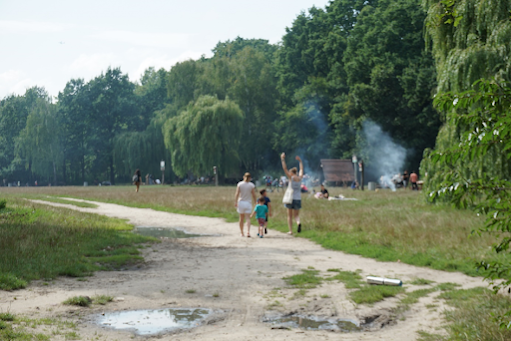
The recreational area in Powsin offers barbecue facilities, a variety of sports activities, playgrounds and small forest restaurants
Sobieski Forest
(Las Sobieskiego). A variety of forests on the eastern side of the Vistula. Take the local train to Międzylesie.
516 hectares. The most pristine forest in Warsaw, with a variety of wildlife including wild boar, moose, roe deer and foxes, part of which is designated as pristine primeval forest.
Plant new trees in Warsaw – the town want’s trees everywhere
When you’re here, you quickly realise that Warsaw is a green city, but they keep planting new trees and small rooftop gardens have been the latest trend for the last 10 years.
Through the “One Million Trees for Warsaw” campaign, the city government is trying to find new places to plant trees, and an app asks citizens to suggest new places to plant them.

A newly planted tree protected by a small railing and an invitation to join the “One Million Trees” campaign
Parks in Warsaw
The king would have his own leisure park and the high nobility would imitate the king. Over time, these out-of-town parks have come to be located within Warsaw’s city limits, and some of them are works of art.
I have selected a number of parks that I think are worthy of special attention. As I said, it’s a difficult choice, because the city is full of parks, and when you go for a walk, you’re bound to bump into a park or a plant. But I’ve tried to provide a selection, scattered around the city:
Palace in Wilanow
(Pałac w Wilanowie) Address: ul. Stanisława Kostki Potockiego 10/16. Transport: Bike path, taxi or bus 116 from Warsaw Castle Square.
The Palace of Wilanow is a must-see if you’re in Warsaw for an extended period of time and fancy a day out of town in exciting surroundings. At the same time, you can take a look at the huge residential area that has sprung up right next to it, on what was until 25 years ago a plough field. And a small walk will bring you to the Shrine of God’s Providence, which is mentioned under “Churches and cemeteries”.
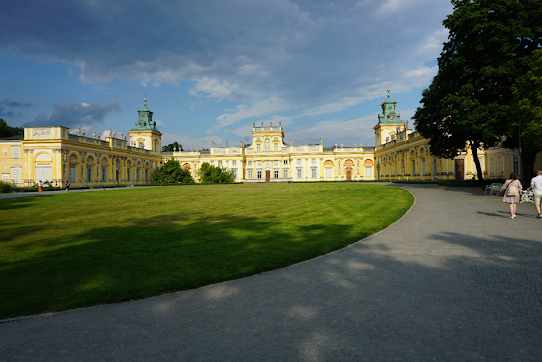
The area around the palace is a popular destination for locals, with a variety of small restaurants and bars
A nice place to stay in the summer time
The palace itself was the summer home of King Sobieski (King 1674-1696), and if you don’t know who King Sobieski was, he was the one who drove the Turks out of Vienna in 1683 and is honoured with his name on cigarette packets, vodka bottles and other interesting places.
The palace is a beautiful baroque construction that houses a collection of old paintings and furniture. What’s really impressive, however, is walking around the surrounding parkland or entering the king’s private garden, which has recently been restored. The ticket price is a modest 7 zlotys, and for that you get access to the king’s private sculptures (he was very fond of naked women) and an elaborately planned garden with various patterns and lakes, as well as greenhouses.
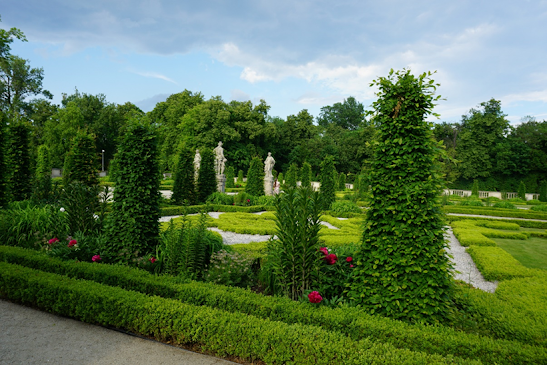
The real garden experience comes when you pay a modest fee to enter and see the King’s garden, which was created with a lot of EU money
A great place to do a lot of things during an excursion out of town
It is possible to visit the palace indoors, walk in the green surroundings with plenty of restaurants, see the new residential areas that begin 3-400 metres from the palace and the enormous church, God’s Providence, with its papal museum, which is located adjacent to the residential area.
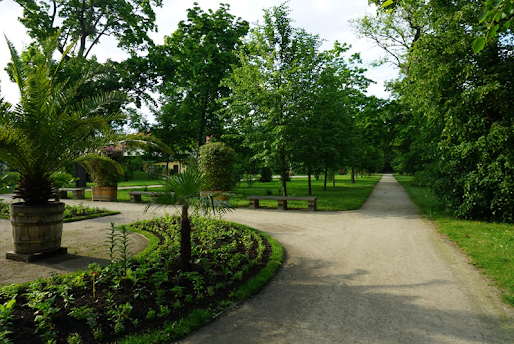
With a lake, art collections and various garden environments, you can easily spend a few hours lazing around here
Łazienki – Polands last king made this park, when the Russians told him not to mingle with politics
– The Old Royal Park close to the centre of Warsaw. Approx. 15 minutes from Politechnika Metro. Aleje Ujazdowskie – close to Belweder Palace, but there are several entrances around.
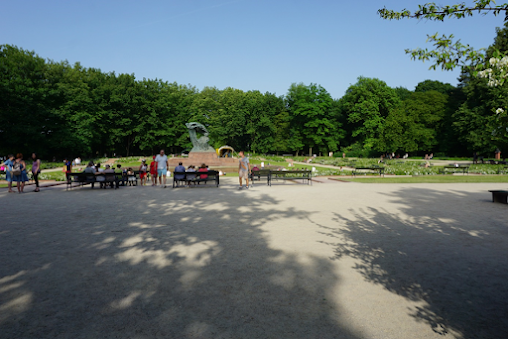
The Chopin statue at the entrance next to the Belweder. Free Chopin concerts are held here every Sunday throughout the summer, with the city’s citizens lounging around the lawn
Łazienki Park in its current form dates back to after 1764, when Poland’s last electoral king acquired the neighbouring Ujazdowskie Castle. A number of mainly Italian architects and painters were commissioned to expand the estate and create a royal summer residence. In the years to come, a park with a summer palace, amphitheatre, orangery and pavilions were created.
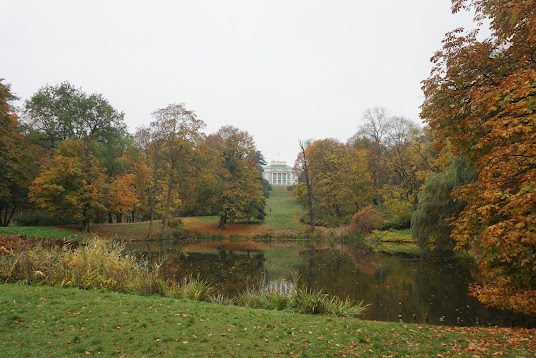
Łazienki Park in autumn, here with a view of Belweder, one of the two palaces in Warsaw belonging to the Polish President
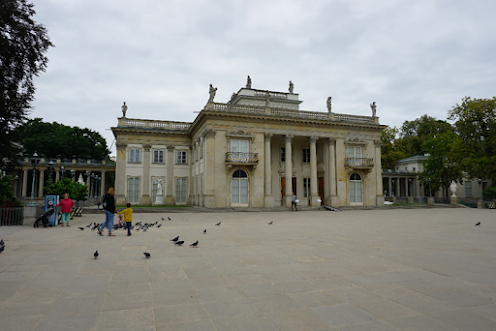
The Palace on the Island or the Palace in the Water – people can disagree wildly about what to call King Poniatowski’s old summer residence
The Polish nobility liked to make landscape parks in their spare time
Landscape parks were a popular pastime for the Polish high nobility in the 18th century and there are several similar parks in Warsaw, but Łazienki is by far the largest and most impressive, and it’s only a stone’s throw from the city centre. The park constantly alternates between different times, countries and continents, between forest-like areas and elaborate floral arrangements.
At the main entrance – close to the presidential palace – the statue of Chopin and the surrounding relaxation area with benches. In summer, concerts are held every Sunday at 12.00 noon – and it’s usually packed with people of all ages.
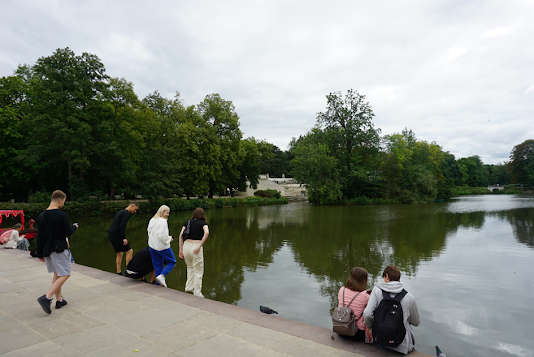
The palace is surrounded by water on all sides. Here you can see a small lake in front of the palace with an excursion boat, and in the background you can see the king’s Roman amphitheatre, perfectly made with broken columns so you can tell it’s really old
Befriend a squirrel
Łazienki Park is also a haven for peacocks, which strut around the palace and theatre. Furthermore, the park is known for its population of squirrels, which are so tame that you can lure them in with a bag of nuts.
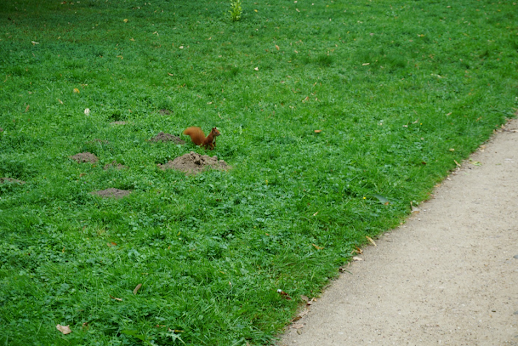
You’ll be pretty unlucky if you don’t meet a squirrel while in the park
A visit to Łazienki is something extra
A stroll in Łazienki is little more than a trip to the local park with a bag of beers from the supermarket (remember that beer/wine can ONLY be consumed in the park’s establishments). It’s an experiential walk where you feel the past and the elegance of the past.
Free admission to the park complex, which offers a wealth of sculptures, architectural masterpieces and ingenious flower arrangements, as well as the Chinese Alley, the Greek Temple, the Amphitheatre and much more. Other paid attractions include King Poniatowski’s Summer Palace (Palace on the Island or Palace in the Water), the Orangery and the Hunter’s Palace. You can buy tickets individually or for all objects for 40 zlotys for an adult ticket.
The zoo
From the Castle Square, take the stairs or escalators down to the main road. Then walk over the bridge and immediately afterwards turn left towards the garden.
It’s a medium-sized, beautiful zoo with a varied selection of animals. Ideal for a trip with the kids. Admission 20-30 zlotys and children 15-20 zlotys (depending on the season).
The Saxon Garden – German kings in union with Poland 1697 – 1763
(Ogród Saski). Located between Plac Piłsudski (10 minutes from Metro Nowy Świat – Uniwersytet) and Plac Bankowy (200 metres from Metro Świętokrzyska).
In the old days – when Poland was in union with Saxony (1697-1763 with interruptions due to civil wars), the palace of the Saxon kings was located on what is now Plac Piłsudski – the capital’s great representative square. And a king back then couldn’t live without a garden. While the palace has disappeared (but … perhaps … is being rebuilt), the garden remains in all its royal splendour. It begins with the Tomb of the Unknown Soldier and continues towards the Great Fountain. The park is filled with Roman-inspired sculptures, ponds and small elegant buildings that complement the trees and flowers. A breathing space right in the centre.

Like many other kings, the Saxon kings were inspired by antiquity
Right in the city centre. If you don’t have much time in Warsaw but want to get a feel for the green city, this is the park to visit.
Park Morski Oko and Park Promenada
Between Puławska 53 (10-minute walk from Racłąwicka Metro), Spacerowa, Promenada and Belwederska streets.
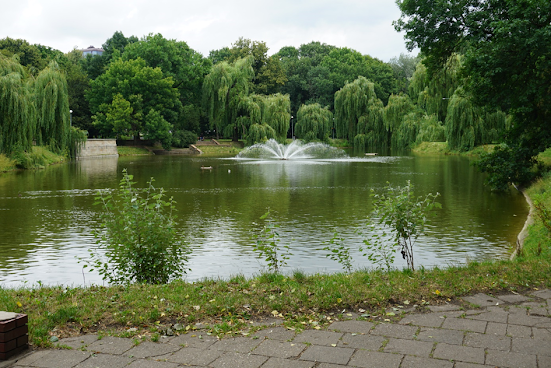
Mighty trees in magnificent surroundings
Located in Mokotow, adjacent to the city centre. Two interconnected parks with lakes, large open spaces and ancient trees. This is an old nobleman’s garden that has developed into a public park.
Pole Mokotowskie
Between the streets Aleja Niepodległości (Metro Pole Mokotowski a stone’s throw from the park), Bartory, Rostafiński, Żwirki i Wigury and Rokitnicka.
A park complex totalling 73 hectares. Former military training ground, later an airport. Today it is an open parkland where Warsaw residents enjoy leisure time with sports and social gatherings. The two traditional bar-restaurants Lolek and Bolek are open to large groups and often host parties and gatherings. But there are also restaurants such as the American chain Jeff’s or Zielona Gęś (Green Goose).
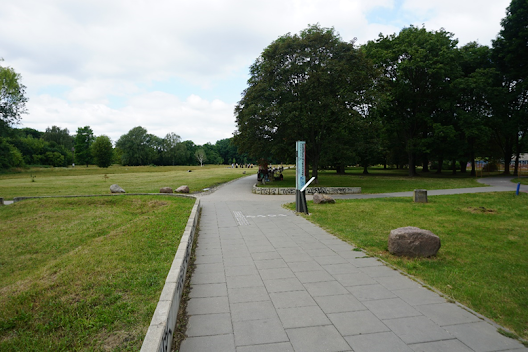
This is it, if it’s going to be recreational, with playgrounds, large pubs and outdoor activities – and it needs to be close to the city centre
Stefan Żeromski Park
Mickiewicza and Krasiński streets. Main entrance at Plac Wilsona (Metro Plac Wilsona across from the main entrance).
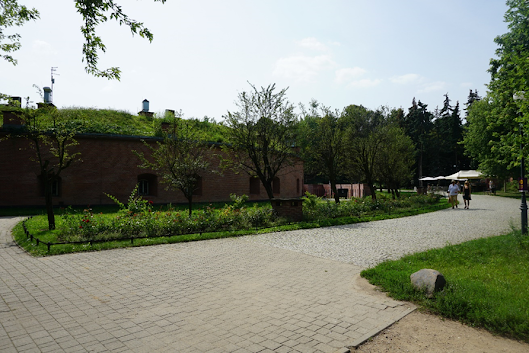
An elegant park on an old military site
Built in the interwar period on an old military site as part of a work programme for the unemployed financed by the state budget and a private gardening company. A large and beautiful park with playgrounds, fountains and special areas for lovers.
Jan Paderewski Park
(Park Skaryszewski im. Ignacego Jana Paderewskiego) Between Aleja Zieleniecka (200 metres from Metro Stadion Narodowe) and Aleja Waszyngtona streets.
Here we are on the other side of the river, in the Praga district, which has a completely different feel to the centre of Warsaw. At the beginning of the 20th century, it was a meadow where livestock grazed. Today, the park is considered one of Warsaw’s most beautiful parks, with large lakes – an English-style parkland spread over 58 hectares.
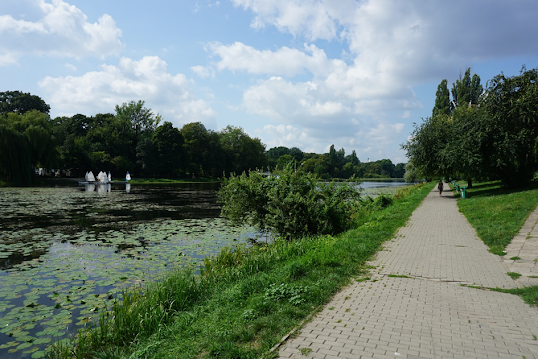
Prague’s large park
From 1573 to 1764, Polish kings were elected by free elections of the entire Polish nobility. Part of the park is a large open area called Kamienkowski Electoral Ground (Kamionkowskie Błonia Elekcyjne), where two Polish royal elections were held, including the last Polish king, Staniswał August Poniatowski, who was probably primarily elected under pressure from Russian soldiers.
The garden on the roof of the University Library
Address Dobra 66. (10 minutes from Metro Centrum Nauki Kopernik).
From the University complex on Krakowskie Przedmiescie, if you walk down the slope towards the river, you’ll come to the University Library – a fascinating building from 1999 that features glass, bronze and vegetation.
This is one of Europe’s largest rooftop gardens and the idea is to connect culture with nature. The supporting columns spread their branches like real trees, blending in with the enormous rooftop garden.
It’s a garden where you want to linger, take a book from the library, and simply sit down and read.
The idea of gardens in new buildings has caught on in Warsaw, with many apartment blocks providing gardens alongside the large apartments, not just on the ground floor, but also on the first and second floors.
The building is a 5-minute walk from the riverside and the Copernicus Centre. The area is also the site of some of the most exclusive residential development in Warsaw.
In addition to the library itself, the library complex houses a number of shops, restaurants and cafés, as well as a number of auditoriums. Aside from reading and borrowing books, the area offers recreational activities and is one of the more popular dating spots.
On the roof, landscape architect Irene Bajerska has created a lavish garden with over 5,000 square metres of vegetation, divided between the roof garden itself and the low-lying garden next to the library.
The roof garden is divided into different sections, each with its own distinctive colour composition, smell and shape.
Almost as impressive as the garden itself are the views on all sides of Warsaw. You look directly down on the Copernicus Centre, glance over towards the Stadium and look up towards the Old Town. At the same time, there are views along the river on both sides.
The garden is open from April to October and admission is free.
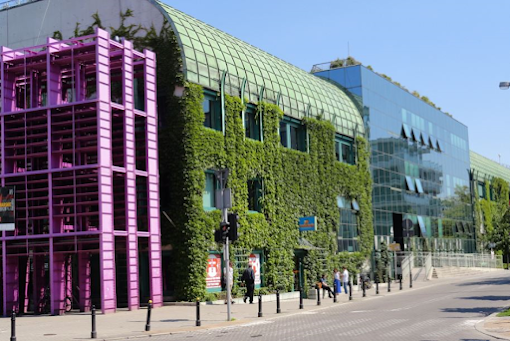
The library from Lipowa Street. The vegetation works wonderfully along copper coated with verdigris.
The pink metal rack in front of the library is some of the shelves from the old library on the university campus.
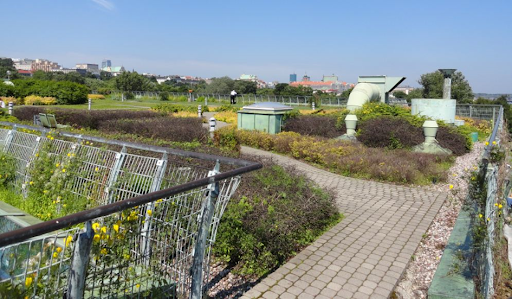
Copper coated with verdigris.to match the vegetation – including the ventilation ducts from the library area
There are some pretty incredible views of the city

From the roof you can look down on the ground level part of the garden
Please send an email to m@hardenfelt.pl if you would like an English-speaking tour guide to show you the most important places in Warsaw.

